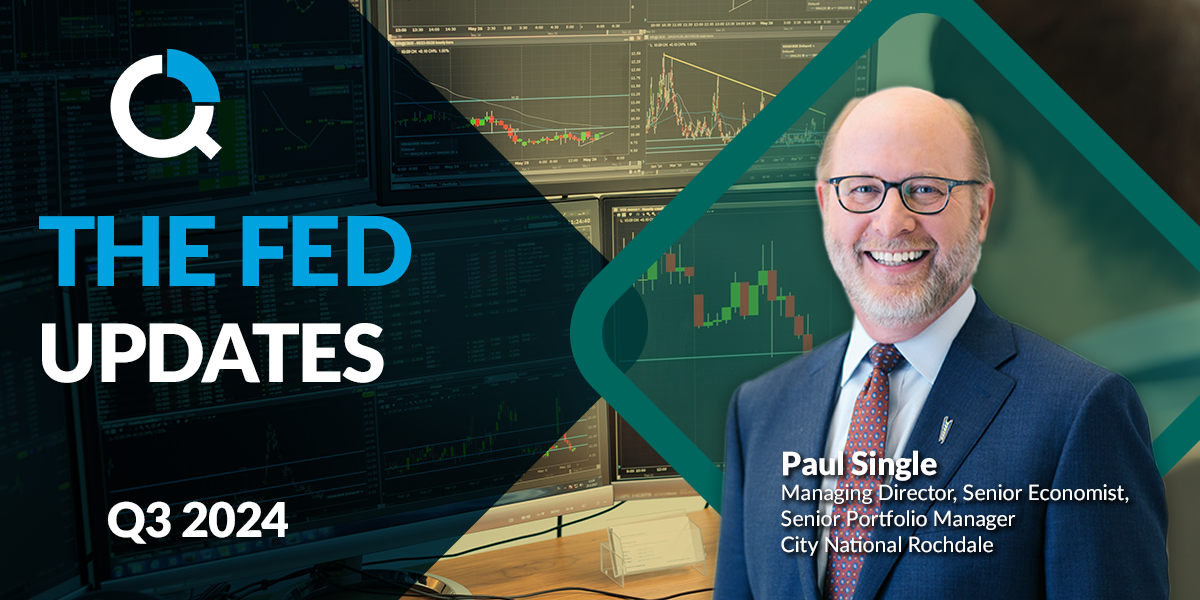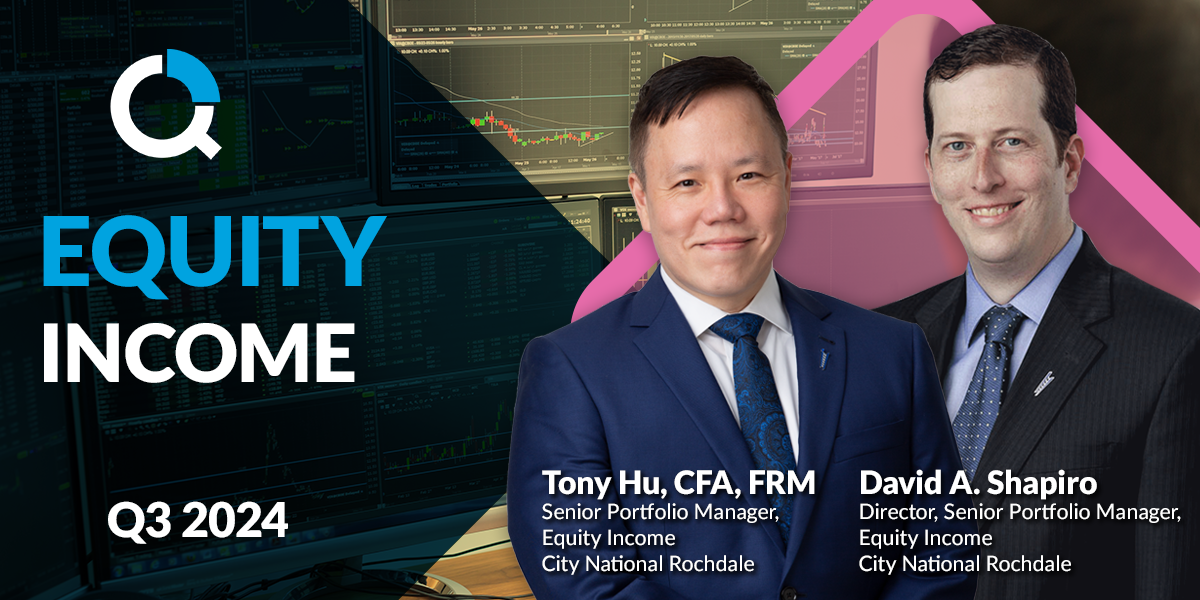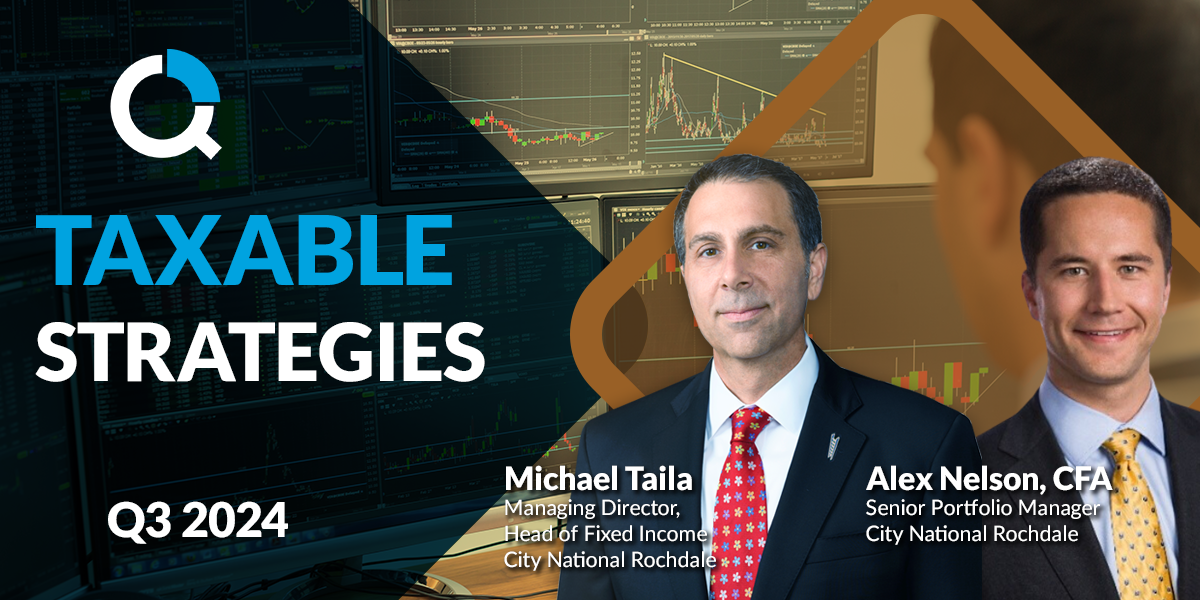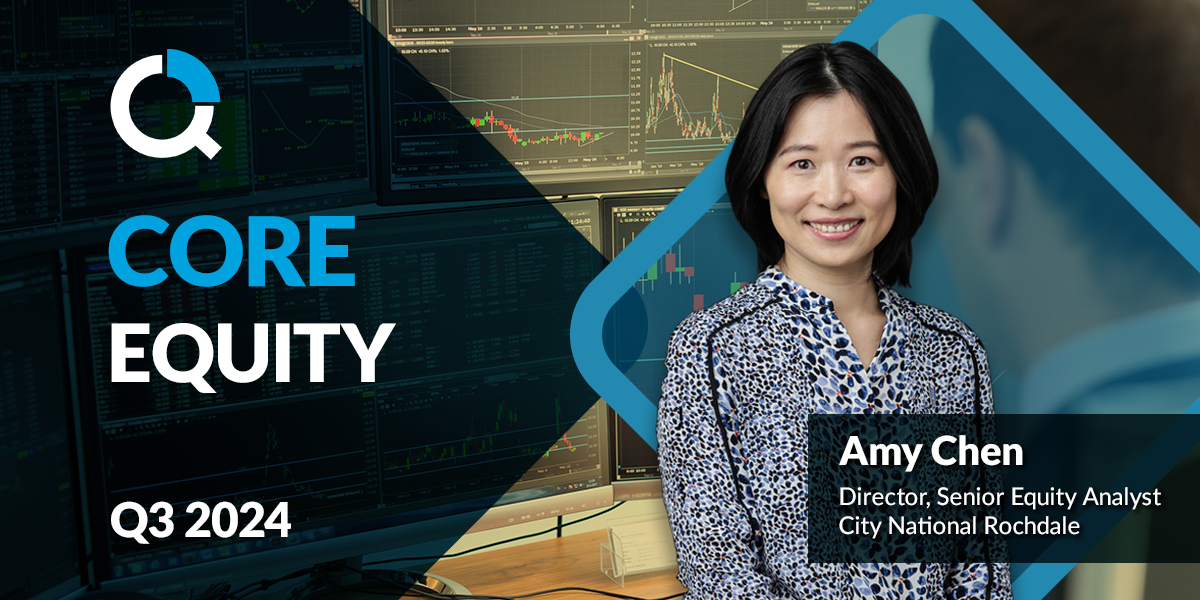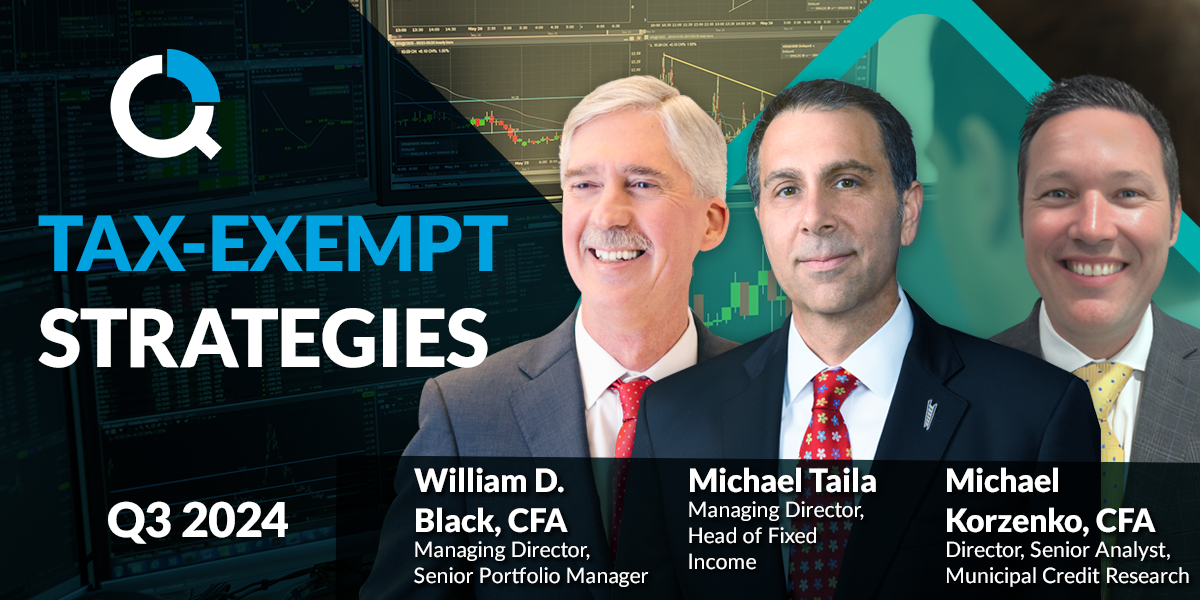
Taxable Strategies:
A Record Quarter as Rates Stabilize
Key Points
- The drop in yields generated one of the best periods on record for fixed income performance.
- As rates stabilize, markets with longer maturities and higher yields may outperform.
- Higher rates are likely to have an impact on borrower balance sheets toward the end of 2024.
The fourth quarter of 2023 marked a decisive shift in sentiment toward interest rates. The U.S. 10-Year Treasury Note1 climbed 0.5%, peaking at 5.0%, and abruptly fell by 1.2%, creating one of the best periods of performance for fixed income markets in history.
The Bloomberg Aggregate Bond Index2 climbed 5.5% over the full quarter but increased 8.0% from the rate peak on October 19 through the end of the year. Bloomberg indices for U.S. High Yield, Leveraged Loans and Emerging Market High Yield also climbed substantially during the quarter, up 6.0%, 3.1% and 5.5%, respectively.3
Chart 1: Bloomberg US Aggregate Fixed Income Index Quarterly Total Returns
Sources: Bloomberg; CNR Research, as of December 31, 2023. Indexes are unmanaged and do not reflect a deduc-tion for fees or expenses. Investors cannot invest directly in an index. Past performance is no guarantee of future results.
Areas with floating rate exposure, such as Leveraged Lending and Collateralized Loan Obligations, lagged other markets with longer maturities.4 However, returns remained positive. Given increased interest in private debt markets and the popularity of floating rate instruments, more traditional assets with fixed rates may perform better as rates stabilize.
Fed policy will remain the most important input on interest rates and returns, especially with respect to high yield. The consensus probability for a recession has fallen in 2024,5 and inflation appears to be on a sustained downward trajectory.6 Investors are more heavily positioned for a soft landing. Interest rates in this scenario will continue to fall. However, if the soft landing doesn’t materialize, higher interest rates relative to the era of zero interest rate policy may begin to erode credit quality.
We are surprised that higher interest rates have not hurt profitability, which would result in decreased interest coverage and an increase in leverage ratios. Ultimately, the one factor keeping the high yield market on track is below-market fixed rates7 as well as little need to refinance obligations in the current market.8 This situation appears poised to last until the end of 2024, when debt maturities begin to rise. Nonetheless, at that point, borrowers will have had plenty of time to position for the impact of higher debt costs and we expect the level of defaults to stay below historical averages of previous credit cycles.
Chart 2: Quarterly HY Bond/Loan Maturities
Sources: J.P. Morgan; S&P/IHS Markit, as of October 10, 2023. Information is subject to change and is not a guarantee of future results.
U.S. High Yield Bonds: Bloomberg: LF98YW Index: The Bloomberg US Corporate High Yield Bond Index measures the USD-denominated, high yield, fixed-rate corporate bond market. Securities are classified as high yield if the middle rating of Moody’s, Fitch and S&P is Ba1/BB+/BB+ or below. Bonds from issuers with an emerging markets country of risk, based on Bloomberg EM country definition, are excluded. “YW” is the ticker to pull the yield-to-worst on the index.
U.S. High Yield Loans: Bloomberg: LF98TRUU Index: The Bloomberg US Corporate High Yield Bond Index measures the USD-denominated, high yield, fixed-rate corporate bond market. Securities are classified as high yield if the middle rating of Moody’s, Fitch and S&P is Ba1/BB+/BB+ or below. Bonds from issuers with an emerging markets country of risk, based on Bloomberg EM country definition, are excluded. This is the total return index level.
1 U.S. 10-Year Treasury, Source: Bloomberg, Ticker: GT10 Govt, Closing Levels
2 Bloomberg U.S. Aggregate Bond Index, Source: Bloomberg, Ticker: LBUSTRUU
3 Bloomberg High Yield Corporate Bond Index, Source: Bloomberg, Ticker: LF98TRUU, Leveraged Loans: Morningstar LSTA Leveraged Loan Index, Source: Bloomberg, Ticker: SPBDAL, Emerging Market High Yield: ICE BofA High Yield U.S. Emerging Markets Liquid Corporate Plus Index, Source: Bloomberg, Ticker: EMHY
4 Morningstar LSTA Leveraged Loan Index (see footnote 3) average duration of 0.25 years vs. Bloomberg U.S. Aggregate Bond Index (see footnote 3) average duration of 6.25 years, Source: Bloomberg, Tickers: Refer to footnote 3.
5 United States Recession Probability Forecast, Source: Bloomberg, Ticker: ECRPUS 1Y
6 U.S. Personal Consumption Expenditure Core Price Index YoY, Source: Bloomberg, Ticker: PCE CYOY
7 Bloomberg High Yield Corporate Bond Index coupon field, Source: Bloomberg, Ticker: LF98TRUU, Field: CPN
8 JP Morgan Bonds and Loans Maturities
Past performance is no guarantee of future results.
Index performance is provided as a benchmark. It is not illustrative of any particular investment. Indices are unmanaged, and one cannot invest directly in an index. Index returns do not reflect a deduction for fees or expenses.
Indexes are unmanaged and do not reflect a deduction for fees or expenses. Investors cannot invest directly in an index.
Important Information
The views expressed represent the opinions of City National Rochdale, LLC (CNR) which are subject to change and are not intended as a forecast or guarantee of future results. Stated information is provided for informational purposes only, and should not be perceived as personalized investment, financial, legal or tax advice or a recommendation for any security. It is derived from proprietary and non-proprietary sources which have not been independently verified for accuracy or completeness. While CNR believes the information to be accurate and reliable, we do not claim or have responsibility for its completeness, accuracy, or reliability. Statements of future expectations,estimates, projections, and other forward-looking statements are based on available information and management’s view as of the time of these statements. Accordingly, such statements are inherently speculative as they are based on assumptions which may involve known and unknown risks and uncertainties. Actual results, performance or events may differ materially from those expressed or implied in such statements.
All investing is subject to risk, including the possible loss of the money you invest. As with any investment strategy, there is no guarantee that investment objectives will be met, and investors may lose money. Diversification may not protect against market risk or loss. Past performance is no guarantee of future performance.
There are inherent risks with equity investing. These risks include, but are not limited to stock market, manager, or investment style. Stock markets tend to move in cycles, with periods of rising prices and periods of falling prices.
There are inherent risks with fixed income investing. These risks may include interest rate, call, credit, market, inflation, government policy, liquidity, or junkbond. When interest rates rise, bond prices fall.
Bloomberg risk is the weighted average risk of total volatilities for all portfolio holdings. Total Volatility per holding in Bloomberg is ex-ante (predicted) volatility that is based on the Bloomberg factor model.
Municipal securities. The yields and market values of municipal securities may be more affected by changes in tax rates and policies than similar income-bearing taxable securities. Certain investors’ incomes may be subject to the Federal Alternative Minimum Tax (AMT), and taxable gains are also possible. Investments in the municipal securities of a particular state or territory may be subject to the risk that changes in the economic conditions of that state or territory will negatively impact performance. These events may include severe financial difficulties and continued budget deficits, economic or political policy changes, tax base erosion, state constitutional limits on tax increases and changes in the credit ratings.
Index Definitions
The MSCI EAFE (Europe, Australasia, Far East) Index is a free float-adjusted market capitalization weighted index that is designed to measure developed equity market results, excluding the US and Canada.
The MSCI Emerging Markets Index is a free float-adjusted market capitalization weighted index that is designed to measure equity market results in the global emerging markets, consisting of more than 20 emerging market country indexes.
S&P 500 Index: The S&P 500 Index, or Standard & Poor’s 500 Index, is a market-capitalization-weighted index of 500 leading publicly traded companies in the US It is not an exact list of the top 500 US companies by market cap because there are other criteria that the index includes.
Bloomberg Barclays US Aggregate Bond Index (LBUSTRUU): The Bloomberg Aggregate Bond Index or “the Agg” is a broad-based fixed-income index used by bond traders and the managers of mutual funds and exchange-traded funds (ETFs) as a benchmark to measure their relative performance.
GT10: US Government Treasury Yield
Bloomberg Municipal Bond Index: The Bloomberg US Municipal Bond Index measures the performance of investment grade, US dollar-denominated, long-term tax-exempt bonds.
Bloomberg Municipal High Yield Bond Index: The Bloomberg Municipal High Yield Bond Index measures the performance of non-investment grade, US dollar-denominated, and non-rated, tax-exempt bonds.
S&P Leveraged Loan Indexes (S&P LL indexes) are capitalization-weighted syndicated loan indexes based upon market weightings, spreads and interest payments. The S&P/LSTA Leveraged Loan 100 Index (LL100) dates back to 2002 and is a daily tradable index for the US market that seeks to mirror the market-weighted performance of the largest institutional leveraged loans, as determined by criteria. Its ticker on Bloomberg is SPBDLLB.
Bloomberg US Corporate Bond Index: The Bloomberg Barclays US Corporate Bond Index measures the investment grade, fixed-rate, taxable corporate bond market. It includes USD-denominated securities publicly issued by US and non-US industrial, utility and financial issuers.
Bloomberg US High Yield Index: The Bloomberg US Corporate High Yield Index measures the performance of non-investment grade, US dollar-denominated, fixed-rate, taxable corporate bonds.
Bloomberg: LF98TRUU Index: The Bloomberg US Corporate High Yield Bond Index measures the USD-denominated, high yield, fixed-rate corporate bond market. Securities are classified as high yield if the middle rating of Moody’s, Fitch and S&P is Ba1/BB+/BB+ or below. Bonds from issuers with an emerging markets country of risk, based on Bloomberg EM country definition, are excluded. This is the total return index level.
Morningstar SPBDLLY Index: Yield to maturity time series of the Morningstar LSTA US Leveraged Loan 100 Index. The Morningstar LSTA US Leveraged Loan Index is a market-value weighted index designed to measure the performance of the US leveraged loan market.
Bloomberg Investment Grade Index: The Bloomberg US Investment Grade Corporate Bond Index measures the performance of investment grade, corporate, fixed-rate bonds with maturities of one year or more.
Bloomberg Municipal Bond Index: measures the performance of investment grade, US dollar denominated, long term tax exempt bonds.
Bloomberg US Treasury Index: includes all publicly issued, U.S. Treasury securities that are rated investment grade, and have $250 million or more of outstanding face value.
Investment Grade (IG) Municipal Bond Index: The Bloomberg US Municipal Bond Index measures the performance of investment grade, US dollar-denominated, long-term tax-exempt bonds.
High Yield (HY) Municipal Bond Index: The Bloomberg Municipal High Yield Bond Index measures the performance of non-investment grade, US dollar-denominated, and non-rated, tax-exempt bonds.
Definitions
Yield to Worst (YTW) is the lower of the yield to maturity or the yield to call. It is essentially the lowest potential rate of return for a bond, excluding delinquency or default.
P/E Ratio: The price-to-earnings ratio (P/E ratio) is the ratio for valuing a company that measures its current share price relative to its earnings per share (EPS).
City National Rochdale Proprietary Quality Ranking formula: 40% Dupont Quality (return on equity adjusted by debt levels), 15% Earnings Stability (volatility of earnings), 15% Revenue Stability (volatility of revenue), 15% Cash Earnings Quality (cash flow vs. net income of company) 15% Balance Sheet Quality (fundamental strength of balance sheet).
*Source: City National Rochdale proprietary ranking system utilizing MSCI and FactSet data. **Rank is a percentile ranking approach whereby 100 is the highest possible score and 1 is the lowest. The City National Rochdale Core compares the weighted average holdings of the strategy to the companies in the S&P 500 on a sector basis. As of September 30, 2022. City National Rochdale proprietary ranking system utilizing MSCI and FactSet data.
Non-deposit investment Products are: • not FDIC insured • not Bank guaranteed • may lose value
Stay Informed.
Get our Insights delivered straight to your inbox.
More from the Quarterly Update
Put our insights to work for you.
If you have a client with more than $1 million in investable assets and want to find out about the benefits of our intelligently personalized portfolio management, speak with an investment consultant near you today.
If you’re a high-net-worth client who's interested in adding an experienced investment manager to your financial team, learn more about working with us here.

